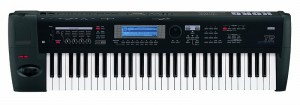
This is my review of iRacing. For those of you who may not know what iRacing is, you can get some more information by going to their website at www.iracing.com. Essentially, iRacing is a racing simulation that spans almost all forms of racing on asphalt or concrete – NASCAR, IndyCar, CART (or Champ Car), Touring Car, Formula 1, and just about anything else you can think of. The only form of concrete racing not included in iRacing is Drag Racing – and at this point in time I’m not sure if that is ever going to be implemented.
The first thing to remember is that iRacing is a simulation. It is not an arcade racing game like Grand Tourismo, or Need for Speed, or (some might argue) DiRT. It doesn’t come with an “arcade mode” like NASCAR Racing 2003 Season. It is a hardcore racing simulation. As such, there is a rather steep learning curve associated with it, and those new to racing need to understand that they can’t simply get into the car and think they are going to be the next Dale Earnhardt Jr. or A.J. Foyt the first time (or even the 100th time) on the track.
HISTORY -
iRacing has a rather unique history compared to other racing simulations, and even video games in general. It had it’s genesis in NASCAR Racing 2003 Season, the last racing simulation released by the now defunct company Papyrus Development Group. Without going into too much detail, the original developer of the NASCAR Racing simulation franchise, David Kaemmer, developed FIRST.net after he left Papyrus (before Papyrus shut down and Electronic Arts acquired the rights to develop NASCAR video games – a curse for those of us who were NASCAR Racing sim junkies). FIRST.net then acquired the legal rights to the code of NASCAR Racing 2003 Season, and soon after, spread the word they were looking for beta testers for a new, secret project (which was to become iRacing).
Unfortunately, soon after came the event that has become extremely controversial ever since.
One of the beta testers reverse engineered the NASCAR Racing 2003 Season code by – essentially – hacking the executable to create a modification of the NR2003 sim for open wheel racing (ala, CART, F1, etc.). He, and a couple others, then placed this “mod” on a website they owned available for download to sim racers. The modification also removed the CD check – which made it possible for someone to easily pirate the original sim. Things got ugly when he was given a cease and desist from FIRST.net… and the ensuing mess continued to escalate until it ended up with FIRST.net suing him, and a couple others, in court due to copyright infringement and breach of a Non-Disclosure Agreement.
If you are interested, you can review the actual court document here to get the facts of the case: iRacing Court Case.

This had the unfortunate side effect of immediately putting FIRST.net and Kaemmer in a bad light, as many people in the sim racing community were friends with the individuals who had been sued, and believed that Kaemmer and FIRST.net had only done it to “protect their interests” financially. The irony is that this is nothing different than any other company would do were their copyrights infringed upon – and those in the sim racing community who side with the respondents in this case either simply do not know the facts (or don’t care), or have a grudge because someone they knew was sued. As a result, the initial opening of iRacing in August, 2008 was boycotted by those in the sim community who had this grudge, and it didn’t take off as quickly as it might have otherwise.
However, interest in the simulation continued to gain momentum throughout the next couple years, and the grudge against iRacing has slowly taken a back seat, with only a few die hard holdouts refusing to try iRacing.
In regards to the code itself, aspects of the NASCAR Racing 2003 Season simulation were initially used as a basis for the simulation’s code as a starting point, but as the development of the simulation progressed, those elements were slowly replaced and phased out by updated and more realistic elements until the current version of iRacing is a wholly separate and independent product of it’s own.
THE SERVICE -
iRacing, in many ways, is comparable to Massively Multiplayer Online games such as World of Warcraft, RIFT, City of Heroes, Champions Online, and Star Trek Online in that it requires a monthly fee to use the service – although it is only $12 a month compared to the typical $14.99 a month. iRacing also provides bulk rates in 3, 12, and 24 month rates, each with a percentage discount on the monthly price. In addition, like an MMO, it creates an online community that allows “in game” interaction between other race car drivers in all of the events they are eligible for. The obvious main difference is that this is a racing simulation, and not a fantasy, shooter, or superhero game.
Most interaction comes by way of the iRacing member website. It is an active web application that is the core of the driver’s interface with the iRacing experience. The top of the webpage contains “at a glance” information regarding the driver’s status, Safety Rating, current License information, and other data. It is also where the user will select either Test or Race to actually enter the simulation and drive.

The one thing of note is that the iRacing system keeps detailed information about every lap of every race or time trial that a driver runs. Statistics and other data can be brought up by the click of a mouse, from fastest lap times to race summaries to a detailed analysis of the race itself, lap by lap. Other information, such as incidents, safety rating points, and license points (all explained below) can be viewed here as well. A member can look up any other member and also view that member’s racing history, as well as compare their own racing achievements with fellow competitors.
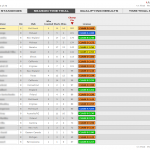
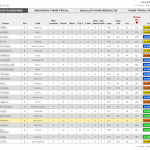
(Note – mouse over each image before clicking for a description)
Members can also paint their helmet, driver / pit crew suit, and car on the web page via it’s stock paint schemes and sponsors to choose from. The available schemes for each car, as well as fonts for the numbers and sponsorship choices actually allow for a great deal of flexibility, and it’s rare that one sees cars painted in similar designs. Additionally, in 2010 iRacing developers included the added feature that one can paint their own car using templates provided by iRacing… once placed in a specific directory in the simulation those paint schemes override the default ones. This provides individuals with the opportunity to customize their own car designs – and coupled with websites like Trading Paints, allows for drivers to download cars of friends and fellow competitors.
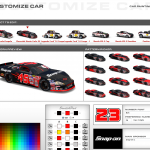
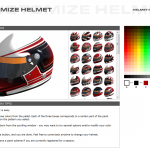
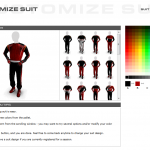
(Note – mouse over each image before clicking for a description)
Additional provided services are a robust Forum for the community, detailed information on each car and track available within the simulation, and detailed information on each series available to race in the sim. The iRacing store allows a user to purchase additional cars and tracks (explained below) through the site itself, as well as the opportunity to schedule a race hosted by themselves, where a user can invite other drivers to participate (this is provided the opportunity for online racing Leagues to move their Leagues to iRacing).

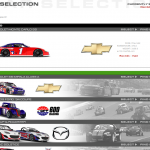
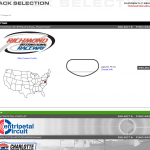
(Note – mouse over each image before clicking for a description)
One of the most important services offered, is an 8 part series of videos put together as a Racing School to introduce newer drivers to the concepts, mechanics, and required skill developments to be good, clean, competitive race car drivers. These detail the physics of the car, and how important weight transference is in relation to the performance of the car on the track, to cornering techniques, downshifting, and racing etiquette and driver responsibility. Some of the videos have actual interactive sessions where a driver can practice on a specialized track setup the concepts that a particular video covered. Part of the Driving School is also the “Sporting Code” document that clearly details what iRacing expects from all of it’s subscribers as far as racing ethics and conduct is concerned – all drivers are supposed to read this document as a requirement.
You can actually view these videos on YouTube here: iRacing Driver School
Lastly, there are Achievements and Awards that a driver can earn on their way up the competition ladder as well… such things as running two consecutive races cleanly with no incidents, watching the Racing School videos, winning your first race, running 100 competition laps, etc.
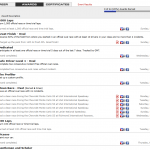
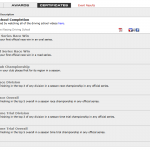
(Note – mouse over each image before clicking for a description)
To view the details of membership, which I won’t go into at length here, click here: iRacing Membership package
The main thing to note is that the initial, starting membership package includes 6 cars (2 with two different versions – the Legends car, and the Solstice), as well as 9 tracks (5 oval tracks, and 4 road tracks).
This provides the new driver with all the tracks and cars they need to participate in the Rookie series championships for both Oval and Road Race races. Additional cars and tracks, once the driver’s license has increased, may be purchased for use, and typically run $11.95 or $14.95 per item (with most running $11.95 on average). While at first this may seem expensive, a user only needs to download the items they wish to use. For example, if a user wished to participate only in Oval racing venues, and initially only with the Late Model car, they would only need to purchase the tracks they need and the Late Model car (and the track purchases need only be made as the schedule reaches those tracks the user has not yet purchased).
For a full listing of the cars available, click here: iRacing full car availability list
For a full listing of the tracks available, click here: iRacing full track availability list
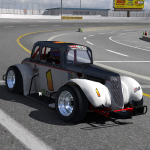
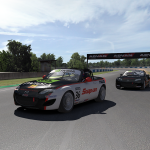
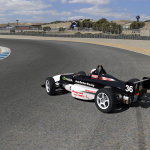
(Note – mouse over each image before clicking for a description)
LICENSES, SAFETY RATINGS, AND CHAMPIONSHIPS -
iRacing was developed, at it’s core, to be not only a auto racing simulation, but to also actually simulate a driver’s career in racing and their advancement through the lower tier racing levels to the higher and more professional levels. Additionally, all the racing (currently) is broken up into two divisions – Oval racing, and Road racing. Oval racing of course deals with such racing bodies as NASCAR, ARCA, the SK Modified Series, Legends, etc. Road racing deals with CART/Champ Car, Formula 1, Touring Car, and other road racing venues. Both divisions are raced, and subsequently advanced, independently of one another… although a driver doesn’t have to only race Oval until he gets to a certain level – both divisions can be raced concurrently.
Both divisions are further broke up into “License” levels based on the experience level of the drivers. The current license levels, and their colors, are displayed below in order of progression:

All drivers new to iRacing start with a Rookie License. The initial series levels that a new member to the service will have access to – based on their License – is the Rookie level races and championships. The more a Rookie driver runs races cleanly, and / or runs Time Trial runs, the higher his License points get and eventually they will be promoted to the next License class A driver’s License is based entirely on the sum of their “Safety Points.” Safety Points are assessed at the end of each Race or Time Trial, and are explained further below.
For every actual “contention” participation a driver gets involved in – either Time Trials or a Race – the driver is subject to Safety Point gains or losses. In a Time Trial, a driver gains points the more laps he runs, and the faster his 10 lap time trial block average is at the end of the Time Trial. In a Race, the driver gains points based on how well they finish over their starting position. However – a driver can also lose points; in a Time Trial they can lose points for contact with the wall or losing control of the car (the car slides 90 degrees perpendicular to the racing line). In a Race, the driver can lose points for both contact with the wall and losing control of the car, but also for contact with other cars. These penalties are assessed per incident… not singularly per race.
So, for example, were I to run a Time Trial and hit the wall twice, and lose control of my car once – I’d get assessed for 2 wall contacts and the loss of control. If I ran a race and hit the wall twice, and got in a single wreck where I hit 3 other cars – I’d get assess for 2 wall contacts, as well as 3 separate car contact assessments.

(Note – mouse over the image before clicking for a description)
The gains and losses are tallied at the end of the event to provide the driver with a sum for the Safety Rating points (Rookies are not subject to Safety Rating points – only drivers at License level D or higher are assessed Safety Ratings). If a driver runs a good, clean race, they gain positive points to their Safety Points, and when those points go above 3.00, they will be eligible to advance to the next License rating when the next promotion period begins (at the end of the 12 week Series, or 4 week Rookie series for Rookies). Alternatively – if the driver can get their License points up past 4.00, they are immediately eligible to race in the next License rating (but don’t actually their their License promotion until the next promotion cycle).
Additionally, each driver has what is referred to as an iRating. This rating is a measure of the “professionalism” of the driver in their current License class against all other drivers in that same class. The higher the number, the more professional the driver is. This number also raises and drops based on the results of a race. It is more complex than the Safety Points… being more a measure of the positions gained in a race compared to the iRating of those the driver passed to gain positions (as a general, albeit loose, explanation of the iRating system).
While seemingly overly complex, what this amounts to is simple – race clean and smooth, and you’ll not only advance, but gain experience and a reputation as a clean, competitive driver. Race dirty or don’t practice and learn to control your car, and you’ll never advance. This is important because as one advances, one is exposed to race cars that are faster and more powerful then the lower level cars – just like real life, and these require more concentration and practice to control and race effectively. The system is designed to provide drivers with gaining the experience necessary to compete at the higher levels with the faster cars… but only after having proved themselves on the track by keeping their Safety Points high and advancing their License points.
Furthermore – to advance, a driver has a minimum participation rating – called an MPR – they must meet every week to be eligible for advancement, which is typically 2 races or 4 time trials in a one week period.
Each License rating has it’s corresponding level of competition, and championships associated with it. A driver can select the “Series” link on their user bar on the website to see the list of current series, which will display which ones they are eligible to race in, which ones they may require additional content to be able to race in they are eligible for, and which ones they are ineligible for (while showing them the requirements they must meet gain eligibility).
It is of note that a driver who holds any License level above Rookie can race down if they so choose – in other words, a B License driver could race in any B, C, D, or Rookie race of their choosing. A driver can’t race up until they acquire the appropriate License rating. However, it is of note that if a driver does race down to a level below their License rating, they will not gain Safety Points for that race. They can, however, lose Safety Points should they make contact with the wall or other cars. Such losses will also affect the driver’s iRating as well.
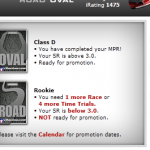

(Note – mouse over the image before clicking for a description)
The realism of the simulation has been noticed by the real world racing community, and with the realism the simulation offers, at the Professional License level (of which there can only be 50 at a time for Road and Oval divisions, respectively) a driver can race to be eligible to compete in actual sanctioned race venues. For Oval drivers, this is the NASCAR iRacing.com Series World Championship (NiSWC), while for Road drivers it is the iRacing.com World Championship Series Road Racing (iWCSRR). These races are actually sponsored by their parent sponsor – in the case of Oval it is sponsored by NASCAR, while in the case of Road it is sponsored by IZOD. Competitors in these Series are the best in their class world wide, and championship standings as well as current race results are displayed on the websites of both NASCAR.Com and IZOD.
THE SIMULATION -
This is where the whole iRacing experience really shines. The simulator itself has several different sections of it’s own right, so I’m going to break them down one by one.
Graphics :
The graphics are some of the best I’ve seen in a racing simulation in quite some time. Note that I said racing simulation, not game… some of the graphics in racing games like the EA NASCAR series for XBox or Need for Speed and such are pretty good, but again – those aren’t simulators. The sim takes full advantage of the latest graphic card possibilities, as well as DirectX 10. There is quite a large selection of graphic tweaks and settings in the sim that one can set to tailor the graphics experience to one’s liking… up to and including whether or not the driver wishes to use mirrors. An additional setting includes a “virtual mirror” which shows up at the top of the cockpit window while driving; it’s field of view can be set to driver preference. This can help immensely with situational awareness, especially in traffic.
While not necessarily a graphics issue of it’s own right, one thing the simulation does not have is changing, or changeable, weather. Reviews of the simulation have been critical of this, since racing simulators as far back as NASCAR Racing 2 included weather effects. However, I’m sure that at some point iRacing’s developers intend to include this. People not as familiar with racing may not realize that weather (not just rain) can make a huge impact on driving and racing the track – colder temperatures mean the tires have more grip, which translates to faster lap speeds… wind can severely affect how the car handles in the corners, etc.

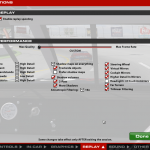
(Note – mouse over each image before clicking for a description)
The one thing that really caught my attention was the detail on the cars themselves. Not only is each car meticulously modeled, but they are rendered just as meticulously. Even the tape is modeled. This really makes the cars look stunning. The only gripe here is that they use a small template size for custom paint jobs… so if one gets extreme close ups of the car, the graphics are slightly pixelated as a result. However – since such extreme close ups usually only occur in custom camera modes during replays, it’s not as big an issue.
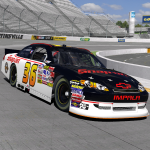
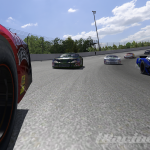
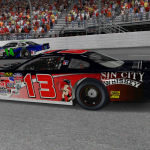
(Note – mouse over each image before clicking for a description)
The damage model is fairly well done as well. Typically, of course, one hopes to not have to actually see damage on their own car… but when it does occur, it is rendered very well. Damage appears on the car where the damage should appear, based on where the car was impacted by the wall or other cars. This can be small dents up to and including situations where the car is largely mangled due to a high speed wreck.
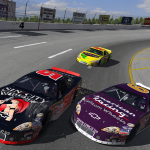
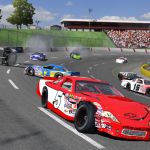
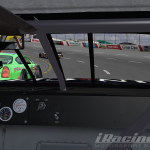
(Note – mouse over each image before clicking for a description)
Sound :
Sound is one of the only things in the sim that I wish could be improved upon. This isn’t to say that the sounds are bad in the sim… but there are definitely areas that could use a bit more of a robust sound sample.
Where as the atmospheric sounds are concerned, there the sim does a good job. The crowd, even some announcer background noises, etc. The spotter and crew chief samples are pretty good, and about what one would expect. The radio crackling is well done and sounds realistic. There are two spotter / crew chief sound samples a driver can choose from – the default, and another selection that’s a bit more raw (and more realistic actually). The sounds of the car hitting the wall and / or another car are actually very well done – they are loud and abrasive, as one would expect, and really jar you out of your seat if the volume is turned up. Hitting the wall hard really “sounds” bad… and even just a scrape along the wall sounds like sheet metal being torn.
However, my issue comes with the engine noise in the car. And since this is a racing simulation, and one spends 90% of one’s time actually inside the car while in the simulation, I would have thought more attention could have been paid to the engine noises.
For the vehicles I currently have access to, some of them have good engine sounds. The Legends car sounds fairly meaty for a small, low (comparatively) horsepower engine, while the Late Model and Street Stock cars actually sound like a Late Model and Street Stock car with it’s deep throbbing, meaty rumble at idle and the loud roar at high RPMs. For the Road cars, the Solstice and the MX-5 actually sound fairly good – since they are based on actual factory cars and you are enclosed within the car, it sounds like what you would expect. However… the Skip Barber Training open wheel car just sounds a bit “tiny” to me – and yes, I do say that with some hesitancy, since I’m not a big open wheel racing fan, so open wheel engines sound somewhat weak to me anyway.
But the car that surprised me the most was the Chevrolet Impala CoT A car (basically, for those of you unfamiliar with it, the car that the drivers race in the NASCAR Sprint Cup series). The engine noise just doesn’t sound meaty and deep enough at all. I mean, even when you watch the races on TV and you hear the filtered engine noises when they show an in-cockpit view of a driver – even that noise sounds more meaty than the iRacing CoT engine. It does have the iconic racing engine whine – but it’s just not what one would expect from a 750 horsepower racing engine.
Despite all that thought, the sounds aren’t bad per se… I just think they could be improved on somewhat in certain areas.
Car Setup and Adjustments :
The setup adjustments for each car are extremely robust. As one would expect, each car has different setup adjustments based on the chassis and model… and it is no small feat to be savvy enough with all the available cars to to be able to quickly create a raceable setup for each one I won’t go into too much detail here, as the dynamics of car setup are a whole, in-depth topic unto themselves, but I will briefly touch on a few of the possibilities within the scope of the simulation.
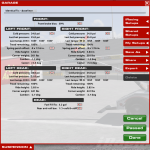
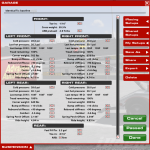
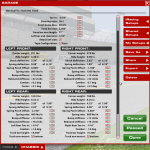
(Note – mouse over each image before clicking for a description)
For those who are not familiar with car setup and that which makes a car fast on the race track, the first thing one has to understand is that a race car is designed and set up completely different than a typical car on the road. The difference lay not so much in that the car is designed for speed… but that the car is designed, and then set up with adjustments for, cornering speed. This is because any car can go fast in a straight line… however, with racing, it’s more about how fast the car can get through the corners… because a fast exit out of the corner means faster straightaway speeds into the next corner - which translates into a faster lap. To that end, any race car spends considerable amounts of time in the garage with adjustments being made to it to allow the driver to run the corners as fast, and as stable, as possible.
It’s all about the physics of how the car handles weight transference when the car accelerates, when it decelerates, or when it enters a turn and then when it exits a turn – and combinations thereof.
Each car’s adjustment pages include just about everything that can actually be adjusted on the real car. The developers of the sim have spend considerable time and investment with real car designers and engineers to ensure that the adjustments available to each car actually mirror the effects their real world counterparts do, and it certainly shows. Even with some of the less complex cars, like the Legends car or the MX-5 Roadster, the adjustments make a huge difference. When dealing with more complex vehicles, like the NASCAR CoT (Car of Tomorrow), the list of possible adjustments is vast – and to make it even more fun, any time you make an adjustment to one thing, it can have the potential to change the way the car behaves enough that further adjustments must be made to other components to make the car stable again. Fun huh?
There’s a reason why almost all racing crew chiefs have mechanical and automotive degrees.
Below is an image of the Chassis adjustments for the Late Model Monte Carlo SS stock car. Each non-changeable component of the chassis actually will change when adjustments are made to other changeable components – most especially to the shocks and springs, since they have a direct affect on the weight put on each wheel of the car. Too soft of a spring, and the ride height for that wheel will drop – potentially drastic spring adjustments can making the body of the car drag the track (if a change is made that actually causes detrimental changes to the car, such as the ride height being too low, the sim will actually alert you to the problem).
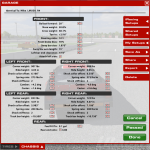

(Note – mouse over each image before clicking for a description)
As a nod to the official rules governing racing in regards to the respective divisions (i.e., Oval and Road), once you have finished making changes and are ready to test the car on the track, selecting Apply will force the changes to the car. It then undergoes an “Inspection” – which is what real race cars are subject to as well. If the car’s settings don’t measure up to the settings for the race, the car will fail the inspection, and you will not be able to get the car on the track until the components that failed the inspection are adjusted to ensure compliance.
One thing I also want to mention – and is something that I was happy to find – is that with iRacing they actually have modeled the ability of the driver to make adjustments to the car while actually driving it. They include things like changing the brake bias, as well as other minor adjustments that real race car drivers use regularly while racing. I know of no other sim that allows this – and it’s a huge boon to be able to adjust your brake bias during a race as the weight begins to change as the fuel burns off (yes, the weight of the fuel has a fairly big impact on the car, and as the fuel burns off, the car gets faster – and as such tighter – due to the less weight).

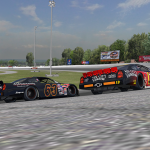
(Note – mouse over the image before clicking for a description)
Lastly, to further the topic on graphics in relation to car setup – changes to the cars that would be visible on a real car (i.e., changes that affect the car outside the body of the car) are actually modeled in the simulation, which is actually really cool. The most easily recognizable adjustments are camber adjustments to the front tires, but you can also notice things such as ride height, subtle things like the rear spoiler angle, and even how strong a car’s shock and spring settings are based on how much the car shifts when cornering, accelerating, and braking.
Physics :
The physics model for the simulation is the best I’ve ever experienced in all the racing simulations I have worked with over the years. The car actually “feels” like a real car… and handles more realistically to what a real car would do under given circumstances. This isn’t to say that other sims, such as NASCAR Racing 2003, don’t include a robust physics model – but iRacing’s physics just feel “right.”
One immediate difference for anyone who’s been racing NASCAR Racing 2003 for years is how the car reacts to slides. In NR2003, usually the car will begin a slide, and the driver will compensate by turning into the slide. Once the slide has been turned into, the car will right itself with a little “wiggle”, and if the driver keeps the “wiggle” from turning too much to the right they can proceed.
A real car is somewhat different – the weight and physics of the car are exaggerated. In the same circumstance, when the car “rights itself,” it will actually snap back to the right instead of just “wiggling.” The driver has to turn into the slide, correct the slide, and then immediately compensate for the snap to the right as well to center the car.
iRacing’s physics model simulates this realism perfectly. It took me some getting used to at first, but now it’s second nature to retard the slide and then immediately turn the wheel into the snap to keep the car out of the wall.
Other things, like acceleration, just feel more robust in the more powerful cars. The NASCAR CoT is extremely difficult to drive… even with a good, solid setup the car feels like it’s driving on ice. Your inputs with the wheel have to be smooth and measured, and your gas and brake inputs have to be smooth and gradual. Any stomping of the gas or brake, or sudden jerk of the wheel, and the car will simply start to lose control. This is again just like the real race car… 750 horsepower is a huge amount of power, and even though the CoT – at weigh-in inspection – has to weigh 3400 pounds, 750 horsepower means the slightest pressure on the gas will spin the tires. The less powerful the car, the less drastic this becomes, but it’s still very noticeable even in the Rookie cars.
The way the weight transfers to the sides of the car during the corners is also very noticeable, and it actually assists a driver in minimizing mistakes and causing a slide out of control. Under most circumstances in a real car, coming into a turn hard will cause the car to “push” – that is, the car won’t want to turn will slide the front end. The fix for this is more let off of the gas until the car settles. In other sims this is modeled well – but with iRacing it just seems to be easier and more natural.
By contrast, when a slide begins – which is referred to as “oversteer” – the absolute last thing a driver should do is hit the brake (which is the usual reaction from rookie drivers based on their real world experience driving cars too and from work or school). It also depends on where the slide occurred; if the slide begins when entering the turn, usually a tap on the gas will halt the slide (this is known as “popping the throttle”), however if the slide begins while exiting the corner after getting on the gas, all that’s needed is simply to let off the gas for a moment before getting back on it. This lets the tires regain grip on the racing surface. It’s important to note that in both circumstances smooth pedal inputs are the key – yanking your foot off the gas or jamming the gas simply exacerbates the problem. NASCAR Racing 2003 simulated these situations well enough, but with iRacing this situation really feels like it should, and it makes escaping a slide much easier once one becomes experienced with it.
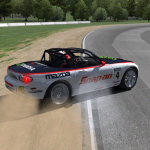
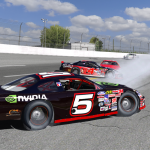
(Note – mouse over the image before clicking for a description)
I mentioned the way the simulation models damage with the graphics engine… but a further note about damage here where physics is concerned needs to be mentioned.
Depending on where the car was actually damaged, the way the car handles can be severely affected as a result of that damage. All racing simulations model this to a greater or lesser degree – but in iRacing, it really affects the car. Even slight body damage can affect the airflow over the car and make the car push on faster tracks – more severe damage can make the car hard to turn, and even cause the driver to blow a tire. I’ve seen wrecks that were so severe that the rear axle of the car was bent at an angle – I was surprised the car could even drive back to the pits.
The only gripe I have here is basically against the tire model… and to be fair, the next incarnation of the iRacing client – iRacing 2.0 (due out in August) – has a completely remodeled tire model, so hopefully this gripe will be fixed then.
The current tire model simulates wear fairly well – but it doesn’t seem to simulate abuse very well. One of the pages a driver can bring up while in the car is a tire page that shows the level of wear on each tire (displayed as a percentage). To test the tire wear – and actual abuse of a tire – I ran 20 laps at Lanier Raceway and intentionally over drove the car in the corner and held the wheel at maximum rotation to slide the right front tire. This of course caused the right front tire to smoke heavily in each turn, all the way through the turn. After 20 laps, I could definitely feel a difference in how much grip I had left when cornering when I started corning normally, but the tire wear on the tire page only showed my tire losing 10% of it’s grip!
That aside however, the rest of the physics model itself is stellar.
The Net Code :
I do also want to specifically set aside a section for the net code of the simulation.
Since almost all of my previous online racing experience has come with NASCAR Racing 2003, NASCAR Racing 2002, and NASCAR Racing 3, I have had to learn to be extremely careful around other cars while in traffic during practice and racing especially. This is mostly due to the net code built into those sims, and how they handle the amount of latency between each driver and the server hosting the race. With those sims, just the slightest touch from one car to another can send one, or both, cars spinning completely out of control. There are even times when the latency is bad enough that one doesn’t even make contact and still knocks another driver out of the race.
iRacing’s net code, while originally based heavily on NASCAR Racing 2003, is a wholly new design. As a result, such issues as with NASCAR Racing 2003 and before are gone.
A driver still doesn’t want to rub up or bump another car if they can avoid it, but now, with iRacing, all that happens if the contact wasn’t hard it’s just a bump. I’ve been in several races where the traffic was intense, and have accidentally bumped – and been bumped by – other cars in the corners to no ill effects other than just getting me loose for a second. Indeed – this makes the infamous passing technique “bump and go” possible – although I wouldn’t recommend it.
Time Trials :
iRacing includes a session type that is referred to as a Time Trial. In a Time Trial, a driver is alone on the track, and has 30 minutes to run at least 10 clean laps. The system then finds the 10 laps with the fastest average lap speed and scores that as the Time Trial.
Many people don’t run Time Trials… and I’m not sure why. I especially recommend running Time Trials to those who are newer to racing, and those who are Rookies – and the reasons why are as follows.
The first thing a Time Trial does is actually get the driver into the long term mindset of running consistent laps.
Most drivers get into a mindset of running “hotlaps” – i.e., the fastest lap they can run. However, hotlaps aren’t what win races – consistency is what wins races (as well as the fact that, typically, hotlaps are run with no regard to tire wear – which, as one might imagine, ends up being a bad thing fairly quickly). A guy who can run a lap 2 tenths of a second faster than I can, but the next lap runs a lap 3 tenths slower than mine (and so forth) is going to lose to me if I can run consistent laps at almost the same lap time lap after lap. The Time Trial forces the driver to consider the whole of his laps, not the singular thereof. Continually running Time Trials begins to put that mindset into the driver so that during races they are subconsciously thinking in terms of consistency over speed.
The second thing Time Trials do is force a driver to run cleanly.
A Time Trial, because it is actually scored, also scores loss of control and contact with the wall – just like in a race. As a result, it forces the driver to – again – consider the long term effects of his laps, and to drive fast and hard, but safely as well. This translates well into actual race situations in traffic – the driver who’s run a lot of Time Trials will be subconsciously considering his car and trying to race as cleanly as possible.
The third thing is that, like mentioned above, a Time Trial is scored.
What this means is that every time a driver runs a Time Trial and runs it cleanly, they get Safety Point increases. They can also lose them if they make contact with the wall or lose control of the car. Now, certainly – they don’t get as many as they do from an actual race, but they still get some. This can help a driver proceed with License advancements – furthermore, it can also assist with regaining any lost Safety Points from their License because of contact and wrecks from a race that goes badly.
Practice, Qualifying, and Racing :
The meat of the simulation itself is the Practices, Qualifying, and of course – Racing… what it’s all about.
Two different kinds of practice sessions are provided to the driver. The first is Testing. This allows the driver to select any one of the cars they own and run it on any track they choose. They aren’t subject to setup inspections (other than obvious faults that wouldn’t allow the car to run). This allows the driver to practice as long as they want or need at a given track, and experiment as much as possible with different setup adjustments in an attempt to build a good race setup. Testing doesn’t get scored in any way, so the driver can hit the walls or slide the car around to their heart’s content with no penalties (the sim does however still display the penalties for such infractions – it just doesn’t score them).
In Race mode however, Practice is a timed event where the driver joins a session with other competitors on the track where the practice is subject to the rules of the given race. As such, if the race is a fixed setup race (which means all the drivers use the same setup – and it can’t be adjusted), only the fixed setup will be available for use to drive – if the race has setup restrictions, they will also be in effect. This allows the driver to get practice in traffic without being subject to scoring, and also allows them more realistic practice at driving the different lines around the track as a result of the traffic.
Since Race Practice isn’t scored, but there are other drivers on the track running as hard as they can, I often use it to pace myself on newer tracks and simply don’t run the races at first (focusing on Time Trials). This is a method I would recommend to others as well.
Once practice is over, it shifts to the next event – Qualifying.
Once the Qualifying session begins, each driver runs a set number of laps as hard as they can, as fast as they can, in an effort to get a grid starting position as close to the front of the grid as possible. Most people understand the process, so I won’t go into detail here.
The next session is the Race itself.

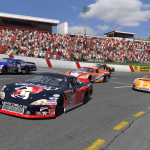
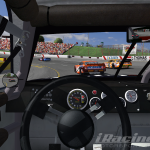

(Note – mouse over each image before clicking for a description)
Regardless of the division, the race session always starts with approximately a 5 minute Warmup period. For shorter races, just getting out and running some quick practice laps is recommended (however – be adviced that it is a Race session – so even though it’s not the actual race, incidents are still counted toward the final Race assessment!). For longer races at the upper License levels, this is a good time to familiarize oneself with one’s pit box location, and practice getting into and out of the pits.
Worth noting – iRacing has designed the simulation so that there is “no-clipping” by vehicles while in the pits. This means that cars can drive through one another once they pass the commitment cones (the effect is negated once they pass by the pit exit cones). This was in effort to minimize pit wrecks… and it does work very well. However, regardless of this, learning to get in and out of the pits while under a green flag quickly and safely cannot be stressed enough. A driver should use the Warmup period on longer races as much as possible to practice pitting, and set in their mind where their pit box is located in the pits. This will pay huge dividends in the long run, I assure you.
When the Warmup period is over – the drivers then have to grid themselves by selecting the Grid button. They have 60 seconds to do so before the race starts, allowing for any final preparations they need. Each division has it’s starting procedure; with Oval racing, there is two pace laps prior to the waving of the green flag (this is known as a “rolling start”). With Road Racing however, the grid is staggered rather than side by side as in Oval racing… and there are no pace laps. Once the green flag waves, each driver has to get up to speed as quickly as possible.
Once the race starts, everything that the simulation offers that I have previously mentioned now comes into play – hardcore. The iRacing Race experience is intense, and it requires all of a driver’s concentration to keep the car under control at competition speed while in traffic. It’s all 100% go until the checkered flag flies.
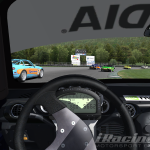
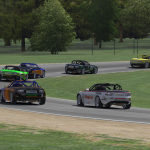
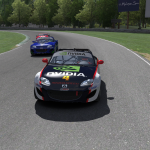
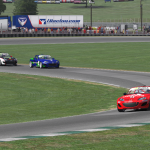
(Note – mouse over each image before clicking for a description)
Lower License ratings typically have shorter races by design (for example, with Oval racing it’s usually 30 to 40 laps in Rookie, 45 to 60 laps with D License, 70 to 120 laps in C License, etc.). This means that the lower rated Series races usually don’t require a pit stop to finish the race, and can be run flat out until the checkered flag flies. The higher the License rating however, the longer the race – and eventually the driver will be forced to pit at least once to finish a race. Additionally, lower level License races don’t fly yellow flags when wrecks or spins occur – this can be both a blessing and a curse, as a driver can get easily caught up in someone else’s mess due to the fact they aren’t sure where the wreck or slide occurred, while at the same time advancing their own position past that of the wrecked or spun cars. Higher level License races include the yellow flag, which brings out the pace car for three laps until the wrecked cars are pitted.
Note here too that cautions are different in Road Racing – in Road races a yellow flag means someone has spun on the track, but the racing doesn’t stop.
All of the flags that govern most racing – whether Road or Oval – are represented… and are flown when necessary to drivers as needed during a race. For example, the blue flag with a yellow X indicates to a driver that the leaders are coming up behind him (this doesn’t mean he needs to “get out of the way”, but if the leaders are obviously faster than the driver being flagged, it’s simply good etiquette to let them pass by). Oval racing doesn’t include the blue and yellow X flag… the spotter generally informs the driver that the leaders are coming. Another example is what’s referred to as the “meatball flag” – a black flag with a dark orange circle in the middle. This is flown to a driver if his car has damage that is ruled to potentially cause problems for other drivers on the track. The driver who has one of these flown for him needs to pit as soon as possible so the pit crew can fix the detrimental damage.
Racing etiquette and “respect on the track” play a huge role in the Race session. Since – most of the time – you are racing against people you do not know personally, everyone expects (well, most everyone) that everyone else will give them the respect they deserve on the track as a competitor. This means of course passing cleanly, giving room when it’s time to give room, not intentionally blocking, and not intentionally wrecking. Incidents are a part of racing whether we all like it or not – sometimes a driver simply loses control of the car because they overdrove it into the corner… or the cut the corner to make a pass and slide up into another car, etc. All that is just part of racing – and everyone understands that. Intentional misconduct however usually is met with rather blistering comments – since this is racing, the competition is intense as one would imagine, and sometimes emotions run high.

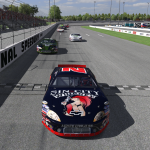
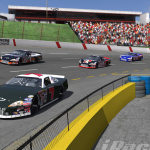

(Note – mouse over each image before clicking for a description)
Once the race is over, the server provides a small amount of time for the drivers to drive to their pit stalls. Once the drivers exit the sim, they are presented with a session pop up page that details the results of the race, displays their Safety Rating gains / losses, and their License point gains / losses. Further data includes a lap by lap analysis, as well as a race graph that shows positions of each competitor lap by lap, and the ability to view your own laps singularly to see how fast each lap was, and if there were incidents counted on which lap.
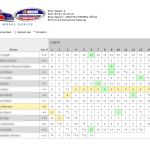
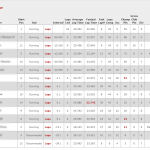
(Note – mouse over each image before clicking for a description)
PERSONAL OBSERVANCES :
I have been racing hardcore racing simulations since the release of NASCAR Racing by Papyrus since 1996, and racing online since NASCAR Racing 3 in 1999, and I can honestly say that I have never had as intense and realistic a racing experience than I have had so far with iRacing. As with any racing online, I’ve had some bad races and some excellent ones – and the really good ones were just an absolute blast. As I increased my License rating up to D, the racing has just gotten even better. Some things I have observed that I would suggest to those starting in iRacing I’ve included below… most of these I’ve followed myself to a relative point of success.
Since each License rating is by design set up for specific driver skill levels, as one would expect the Rookie series are what are referred to usually as “wreck fests.” It is unfortunate side effect of our instant gratification society, and many of these first time drivers don’t bother with the Racing School videos or attempt to practice on the track before they begin racing, not realizing the amount of time they need to put into the sim to be capable of not only running a consistent line around the track, but also driving in traffic at race speed (which is much more difficult than it appears). However, once a driver advances past the Rookie level races, the racing gets much cleaner and better with each License advancement (as a rule – you still run into the occasional “checker or wrecker”).
What I recommend for newer drivers and those new to the service is to run Time Trials as much as possible during your Rookie days. This gets your License points up quickly, and since Rookie seasons only last a month, it means you could be at a D License rating in only 4 weeks at maximum.
Another thing I’d like to mention is for newer drivers to completely ignore the fastest laps during practice of any of the other drivers. Those lap times are “hotlaps” – I can guarantee that those guys aren’t running those lap speeds on a consistent basis. Typically, actual race speeds are slower by up to 5 tenths of a second due to negotiation of traffic and racing side by side (this is, of course, excepting Superspeedway tracks like Daytona and Talladega, where in most cases race speeds are faster than the “hotlaps” due to the draft in big packs).
Case in point – this week’s track for the Late Model Series was Lanier. I simply could not get a setup to respond the way I wanted for this track, driving stable I was almost 3 tenths of a second off the “hotlap” speeds. As a result I assumed I’d just be a problem for others on the track, so for the first 3 days of the week I just ran Time Trials. Last night I went ahead and scheduled a race – and my lap times, while not competitive with the leaders, were comparable to everyone else on the track.
Lastly – get a headseat / mic. The simulation includes automatic voice communication during Practice and Race sessions. I cannot stress this enough – voice communication with the other drivers is almost a necessity. This allows you to hear communication between others for things such as wrecks, and where they are so you can avoid them, to when a driver is going to give you a position and lets you know to go high or low to take it. Some of the best races I’ve experienced with iRacing were because over 70% of the field had voice communication, and we communicated everything that happened during the race.
This can, naturally, be a double edged sword, as some people can prove to be real jerks. But the sim provides an ability to map a key to a “mute” function – which allows you to instantly mute who ever is talking at that moment. Problem solved.
I also want to give a shout to the Replay option. iRacing, like all racing sims, allows a driver to save any session as a replay. There are multiple camera settings in the replay once one is loaded that conform to cockpit views, chase views, etc., but the nice feature is the easy ability to create custom cameras right in the Replay itself on the fly. This makes the creation of movies or tailored screenshots fairly easy and simple.
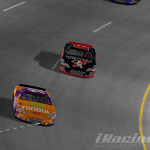
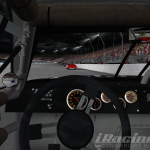
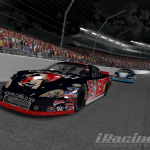

(Note – mouse over each image before clicking for a description)
CONCLUSION :
Well, that’s it. This ended up being a lot more comprehensive than I’d originally planned, but there is a lot of data to cover where iRacing is concerned. As one might be able to tell, I really enjoy the iRacing experience. It doesn’t model only a single type of racing, so you have the ability to switch back and forth as you like, and enter any race type you like on a whim. I’ve never really been much of a fan of Road Racing, but I did finally run my first road race at Lime Rock Park as a Rookie in the Mazda MX-5 – and it was a helluva lot of fun.
One of the things I enjoy the most about the service is it’s attention to detail as far as statistics are concerned, and how it actually models the progression of a driver through their Rookie “years” up into the more professional, faster cars. It really forces a driver who’s truly interested in performing and advancing to the pro levels to step up their game, pay attention to the little things, and drive as clean and smooth as possible – always keeping the long term in mind.
If you are a sim racer at all, and enjoy the more hardcore aspect of online racing, I seriously cannot recommend iRacing to you highly enough. Trust me – once you are past the Rookie series races, you won’t regret it.






























































